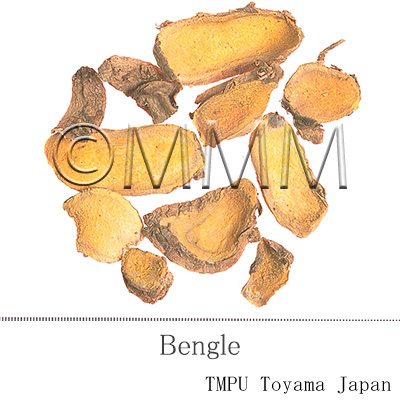Crude drug sample data base
※Click on the image to enlarge it.
The capital city, provincial capital city or the representative
location of its administrative area is indicated.
location of its administrative area is indicated.
-6.597146899999999
106.80603880000001
Production area information
Republic of Indonesia,Bogor, West Java Prov.
https://ethmed.toyama-wakan.net/img/pin_san.png
-6.17511
106.86503949999997
Collection information
Republic of Indonesia,Jakarta Special Capital Region
https://ethmed.toyama-wakan.net/img/pin_nyu.png
Scientific information data base
| Crude drug name | Indonesian name, English name | Bengle | |||
|---|---|---|---|---|---|
| crude drug image |
| ||||
| Original plant name | Zingiber cassumunar Roxb. | ||||
| Family name | Zingiberaceae | ||||
| Used part | Rhizome | ||||
| Distribution area | It is cultivated in Java from lowland up to 1300 m altitude. It is also cultivated in eastern part of Indonesia. | ||||
| Description | The rhizome is pungent and bitter. It has yellow color inside. Because of the bad taste, it is never used as a condiment , but only as a medicine. The plant is a herb, 1.5 m tall with a pseudo stem. Leaves simple, lanceolate, base rounded, apex acute, margin alternate, hairy, 23 to 35 cm long and 20 to 25 cm wide, nerve alternate, green. Flowers reddish green [207, 222]. | ||||
| Drug effect | Warming, drying, cleansing [201]. | ||||
| Specific actions | Carminative, anti-inflammatory, analgesic [231]. | ||||
| Frequency in use | Abundant. | ||||
| Common uses | Indonesian women use rhizomes of Zingiber cassumunar, and other rhizomes from Z. aromaticum, Zingiber officinale, Kaempferia galanga, as a drink to treat various illnesses such as stomachache, diarrhoea/diarrhea and jaundice in fact [201, 222]. | ||||
| Pharmacological effect | Study on the relative curcumin protection by different crude extracts against sulphur free radicals showed that Z. cassumunar gave the highest degree of radioprotection. It reveals the potential medicinal use of the plant as a dietary agent [PMID: 15312045]. (E)-1-(3,4-dimethoxyphenyl) butadiene isolated from Z. cassumunar dose-dependently inhibited the rat ear edema induced by ethyl phenylpropiolate, arachidonic acid and 12-O-tetradecanoylphorbol 13-acetate and it was more potent than any other standard drugs being used [PMID: 12860299]. Two phenylbutenoid dimmers isolated from the rhizomes ofZingiber cassumunar exhibited considerable cyclooxygenase-2 (COX-2) inhibitory activity [PMID: 16272734]. | ||||
| Medical system | Indonesian medicine (Jamu) | ||||
| Traditional usage | The rhizome has warming, drying, cleansing properties and can be used to alleviate pain sensation. It can be used to treat headache, rheumatic, fever, constipation, worm infestation. Poultice made from the rhizome is applied on the forehead to treat headache and it has a calming effect. A mixture of the rhizome with rhizome of Alpinia galanga and Acorus calamus is used after parturition to purify uterus and stop bleeding. When applied in the abdomen, pounded rhizome helps the shrinking of the uterus after parturition. A mixture of roots and cloves is chewed and when swallowed can treat stomach cramps [201, 207]. | ||||
| Formulation | 1) Fever: 15 grams of fresh rhizome is grated and squeezed, add 1/2 glass of hot water and 2 tablespoons of honey, stir, drink the same amount of juice twice a day in the morning and evening [207]. 2) Stomach cramps: 1/2 grams of fresh rhizomes of Z. cassumunar, 3 grams of rhizomes of Curcuma aeruginosa, 3 grams of rhizomes of Boesenbergia pandurata, 1 gram of fennel fruits are boiled or steeped with 110 ml of water to make 100 ml of decoction. Drink the decoction 100 ml (adult) and 25 ml (children) twice a day for 4 days [231]. | ||||
| References | Reference book Tips! | [201] K. Heyne, Tumbuhan Berguna Indonesia, Vols. 1-4, 1987. Diedarkan Oleh Koperasi Karyawan Departemen Kehutanan, Jakarta, Indonesia. Vol. 1, p 568. [207] Badan Penelitian Dan Pengembangan Kesehatan and Departemen Kesehatan, Kesejahteraan Sosial Ri. Vols. 1-5, Inventaris Tanaman Obat Indonesia, Jakarta, Indonesia. Vol. 1, Part 2 (2001), pp 349-350. [222] P.T. Eisai Indonesia: Medical Herb Index in Indonesia (Second edition).1995. p 276. [231] Soedibyo, Mooryati: Alam Sumber Kesehatan: Manfaat dan Kegunaan (Natural resources for health. Benefits and uses). Balai Pustaka. 1998. pp 69-70. | |||
| Research paper | 1. Han AR, Kim MS, Jeong YH, Lee SK, Seo EK. Cyclooxygenase-2 inhibitory phenylbutenoids from the rhizomes of Zingiber cassumunar. Chem Pharm Bull (Tokyo). 53(11):1466-8, 2005. (PMID: 16272734) 2. Han AR, Min HY, Windono T, Jeohn GH, Jang DS, Lee SK, Seo EK. A new cytotoxic phenylbutenoid dimer from the rhizomes of Zingiber cassumunar. Planta Med. 70(11):1095-7, 2004. (PMID: 15549671) 3. Chirangini P, Sharma GJ, Sinha SK. Sulfur free radical reactivity with curcumin as reference for evaluating antioxidant properties of medicinal zingiberales. J Environ Pathol Toxicol Oncol. 23(3):227-36, 2004. (PMID: 15312045) 4. Jeenapongsa R, Yoovathaworn K, Sriwatanakul KM, Pongprayoon U, Sriwatanakul K. Anti-inflammatory activity of (E)-1-(3,4-dimethoxyphenyl) butadiene from Zingiber cassumunarRoxb. J Ethnopharmacol. 87(2-3):143-8, 2003. (PMID: 12860299) | ||||
| Last renewal date | 2024/03/15 | ||||




